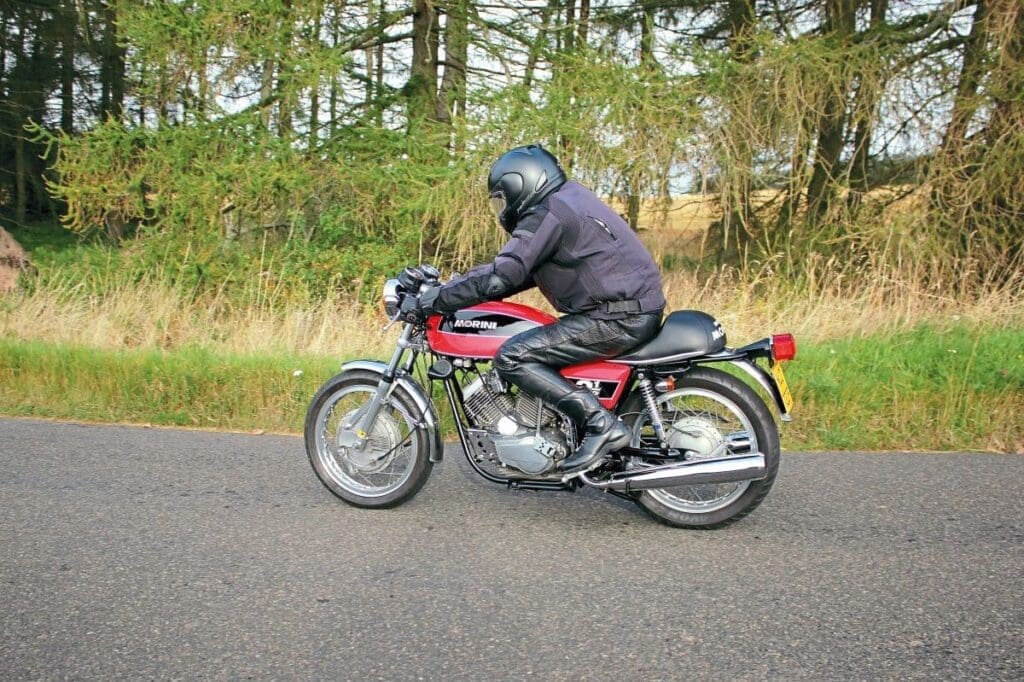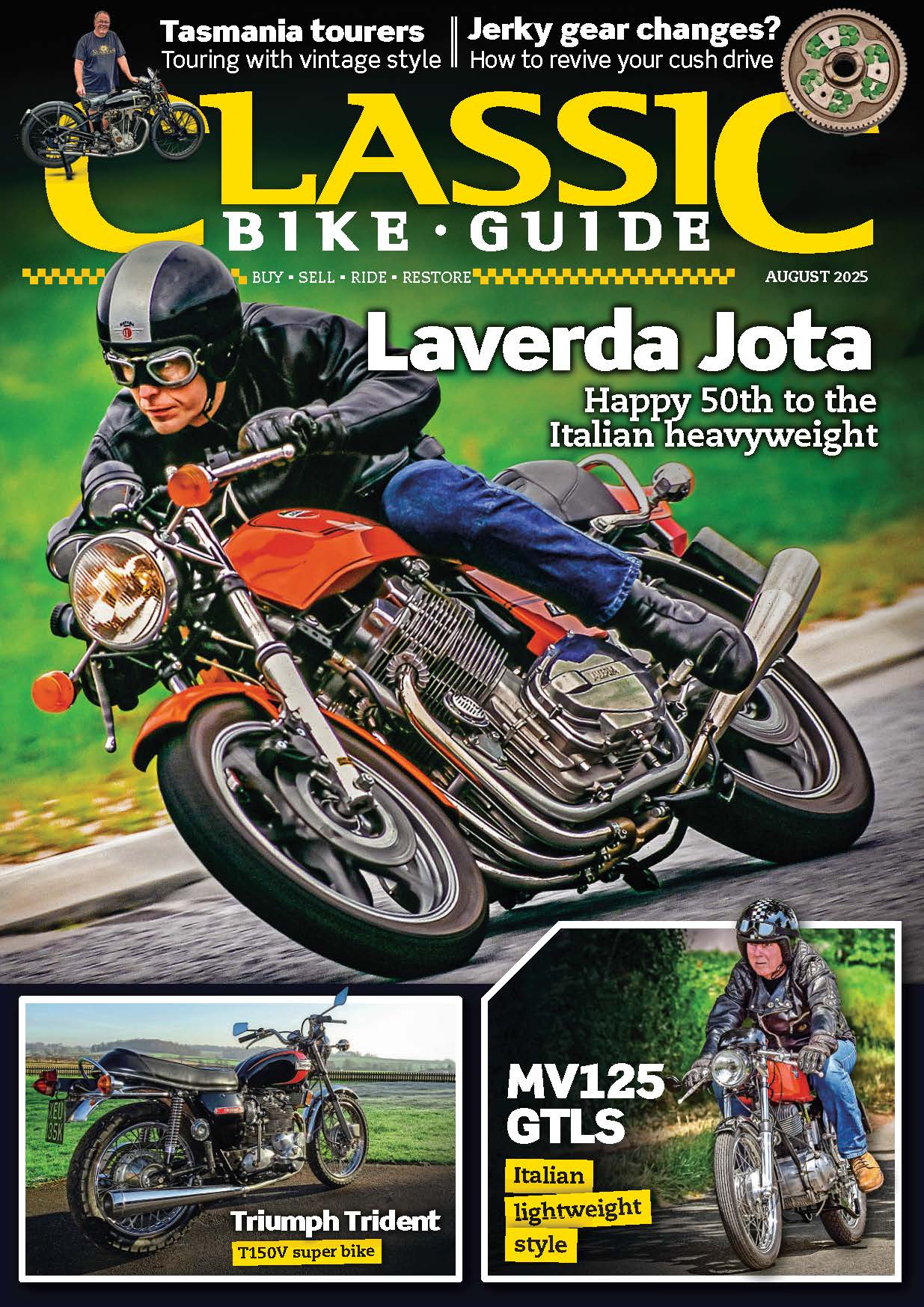To those that haven’t ridden one, a little Italian 350cc V-twin may not sound like perfection – but to those that have…
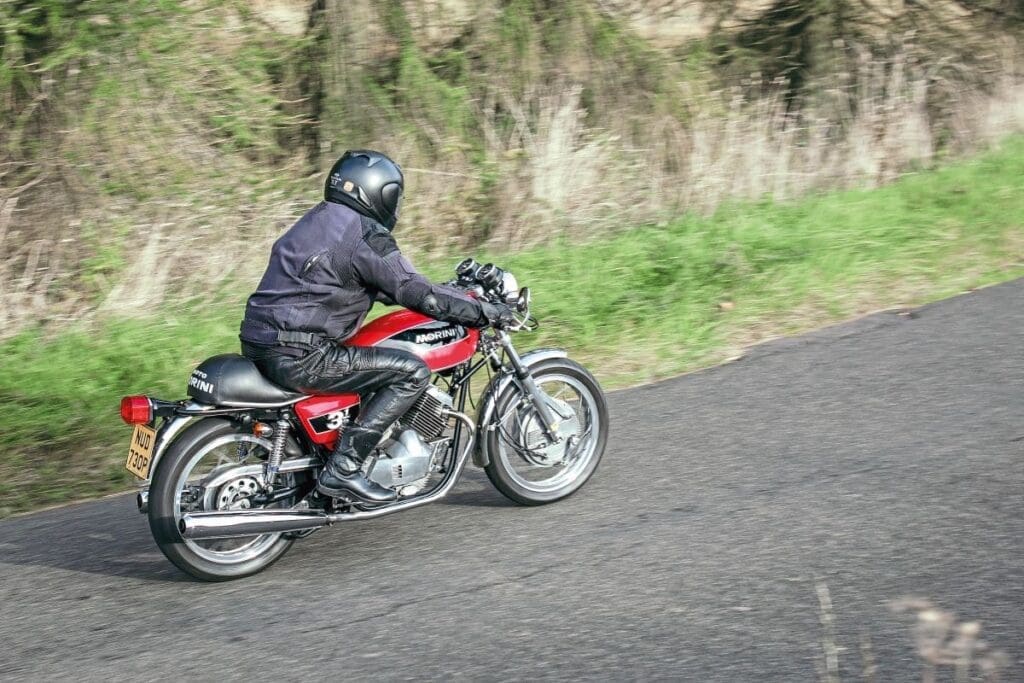
Words and photography by Stuart Urquhart
Mike is a fan of classic sports motorcycles. For argument’s sake, we could even say ‘classic superbikes.’ For Mike has owned more than a few and currently parked in his garage is a gorgeous Moto Guzzi Le Mans 850 (featured in July CBG), a Norton Commando Roadster 750, Honda 400/4 and an extremely desirable Honda VTR1000 SP2. A committed track day fan and a Sunday Trials competitor, Mike is also familiar with ‘getting his knee down’ on a Ducati 996 and ‘foot-dabbing’ a classic Honda Twin-shock 200cc single around local Trials events.
Enjoy more Classic Bike Guide Magazine reading every month.
Click here to subscribe & save.
But as readers will have already guessed, lucky Mike is also the proud owner of this very desirable ‘mini-superbike’ plastered across these colourful pages. Familiar enthusiasts of the breed will no doubt have spotted this is no ordinary Moto Morini either, but an early model 3-1/2 Sport – giveaways being the humungous Grimeca front brake, bump-stop sports seat and in-your-face side panel ‘3-1/2’ white graphic decals. The renowned red and black paintwork, Borrani flanged alloy rims, clip-ons, chrome mudguards and characteristic V-twin engine are also unmistakably ‘Sport’ to committed Moto Morini enthusiasts, opposed to the more ‘everyday’ Strada version, with its more comfortable handlebars, lower compression and a less sporty cam. Thinking back to Mike’s stunning Le-Mans, I asked him, ‘Why follow up your big-bore ‘Guzzi with a 350cc lightweight Morini?’
Mike chuckled. “While I was relaxing one warm summer afternoon admiring my ‘Guzzi over a garden beer, I had a sudden thought – I fancy a Morini Sport! I don’t know what inspired the idea, but that evening I was online looking at potential purchases when I spotted a nice example on Car & Classic website. It looked very original and subsequently I contacted the owner, Simon, who was located in Penzance. Simon was selling because the little Morini was hurting his joints. Well, thanks to my cycling and trials pursuits, the one thing I do possess is supple joints – so I promptly agreed to buy it!”
Mike’s purchase was transported to Fife by Bike SOS and a close inspection revealed that the Morini had obviously been stored for a long period before being tidied up for sale. Sold as a ‘runner,’ Mike was dismayed by tatty paintwork and rusting spokes that online images had failed to reveal. Although the Sport had a new battery, starting proved difficult (not aided by a left-side kick-start), and the engine wouldn’t tickover. Further, the front cylinder proved to be running hot and curiously the V-twin engine had two new NGK sparkplugs fitted, but a different graded cold-running plug was discovered in the front cylinder.
Back to Mike: “Initially I was concerned with the Morini’s running problems, plus a new shining battery and odd plugs spelled ‘prepped for sale’ to me. On contacting Simon, he assured me that the bike was running and had been fitted with a new battery, cambelt and plugs to ensure that any buyer would be satisfied – the ‘odd plugs’ being an oversight for which Simon offered an apology. I also learned that a previous owner had spent considerable money rebuilding the engine. But still harbouring more than a mouthful of buyer’s regret, I decided to go and check out the Morini’s history, and a cardboard box supposedly filled with receipts…”
To Mike’s relief, all paperwork concerning the Morini’s history proved much as Simon had claimed – indeed, a 1993-dated receipt itemised an expensive engine rebuild by engineer Smiths Small Engines. Another from Moto Morini specialist WeeVee of Croydon listed the supply of new parts and several annual services. Miura Engineering of Middlesex had extensively overhauled and rebuilt the front forks the same year. The receipts came with a bundle of old tax discs and MoT certificates – all excellent provenance relating to NUD 730P, Mike’s purchased 1975 Moto Morini Sport. The logbook listed only two former keepers – “another plus,” said a satisfied Mike.
“I decided to remove and inspect both carbs to hopefully sort the erratically running engine. Annoyingly, once I’d removed the front carb’s clamp, I couldn’t then remove it from the manifold, ditto the rear carb. A closer inspection revealed ‘witness marks’ on both float bowls where each had been hammered in an attempt to remove them. After carefully removing each carb and manifold together as one unit, I managed to carefully prise them apart on my vice.
“I next discovered the manifolds too had been twisted out of shape by hasty hammer blows. But, by the careful heating of each manifold using a blow gun, I managed to re-form them back to true by gentle tapping with a hide mallet upon a flat iron plate. Then, I finished each manifold’s flat edges by gentle sanding on emery paper over a sheet of plate glass – quite a labour-intensive job to have to undertake on a proposed running motorcycle! Satisfied, I then fitted new gaskets and seals to both carbs
“A bonus of the above exercise was the revelation that the previously hot-running front cylinder was a result of the damaged manifold introducing an air leak that weakened the fuel mixture. Proof was when I easily balanced the carbs and achieved a nice and steady tickover for the first time. With a return to first kick starting, a test run around back roads was rewarded with a perfectly running engine – I was thrilled. The run revealed a grabby front brake, and this was simply cured by filing and chamfering each of the brake shoe edges in turn, then balancing the reassembled brake in accordance with the manual.
“Then, just as I was beginning to enjoy rides on the little Morini 3-1/2, the cambelt snapped! Back home I was relieved to discover there was no top-end damage when compression tests proved to be excellent – a plus of Heron cylinder head design, or so I’m informed. However, I remain sceptical, as when fitting and timing a new belt I somehow managed to clip a valve with the rising piston, so I count my good luck instead!”
While Mike’s Sport was off the road, he decided to use this downtime to have the scruffy fuel tank and side panels professionally painted by Jacksons of Kelty (which provided an excellent job; proof is in the pictures). While his paintwork was south in Kelty, Mike painted the frame and other cycle parts in gloss black enamel. He also removed and tidied up the mudguards, then studiously polished the spokes and alloy rims to ‘as new’ finish – ditto the sporty rear seat. New Avon Roadrider Mk2s joined the upgrades, as did a pair of new Hagon shocks. Front and rear sprockets plus chain were supplied by MDina Italia of Dorchester. New steering head bearings were sourced from R&M Bearings of Dundee. Mike’s last job was to rebuild and refurbish the front Marzocchi forks with new seals and fluids. Once his painted parts returned, Mike assembled the bike using new stainless fasteners throughout. In less than a week, his transformed Sport was ready to ride once more…
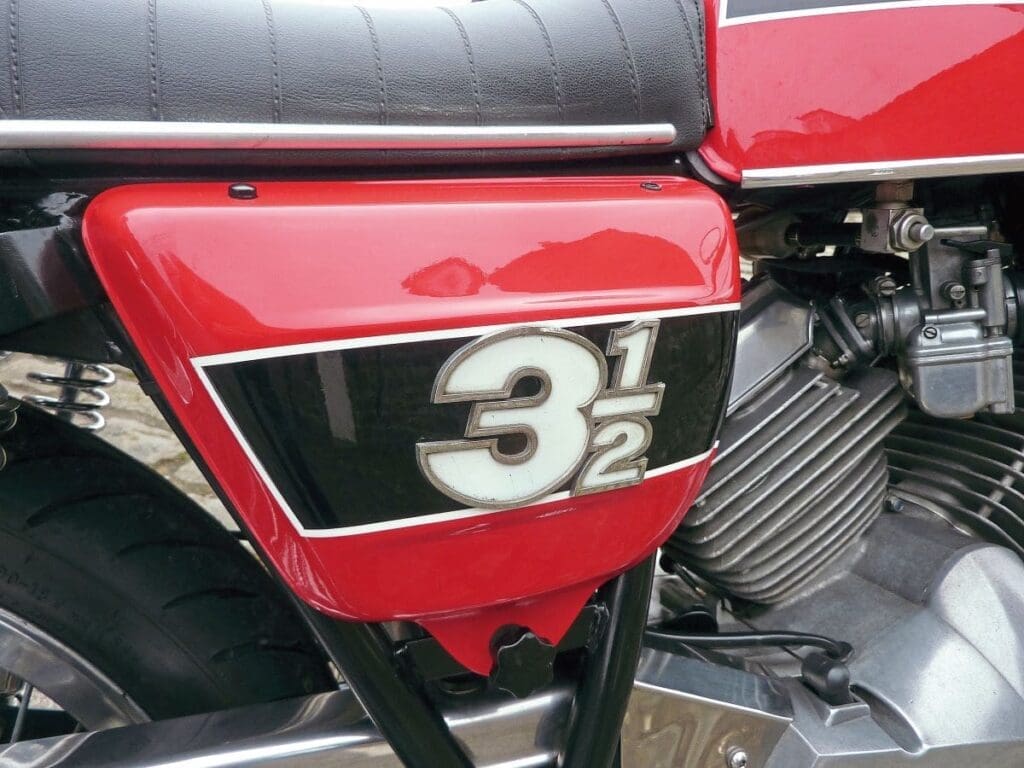
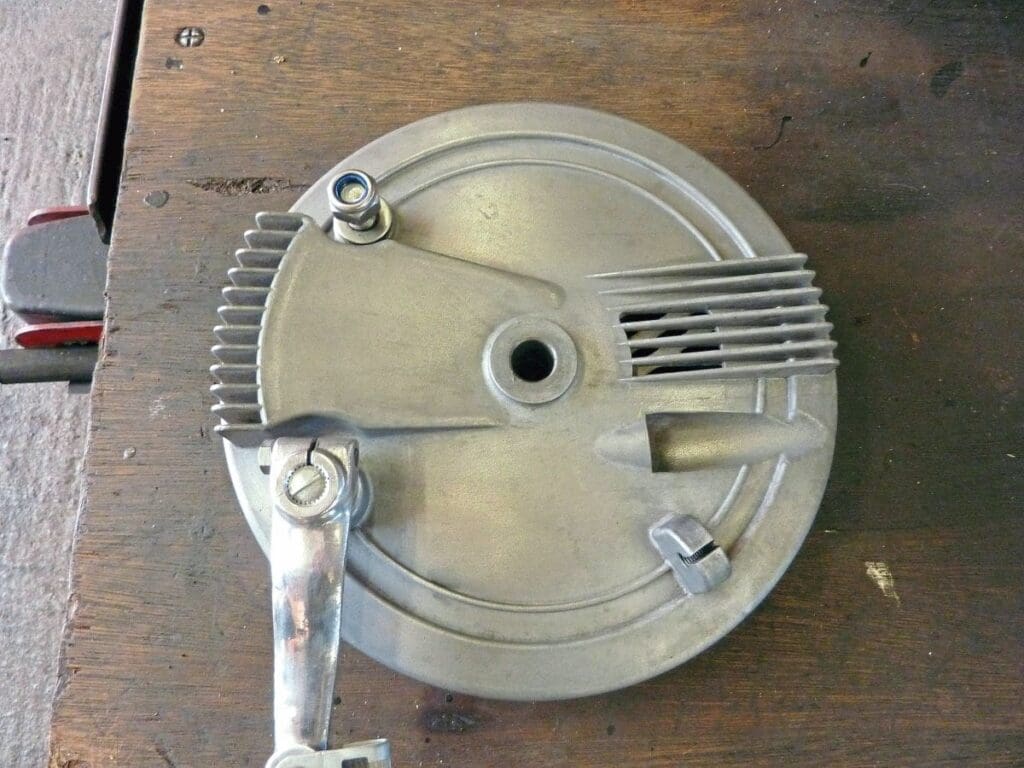
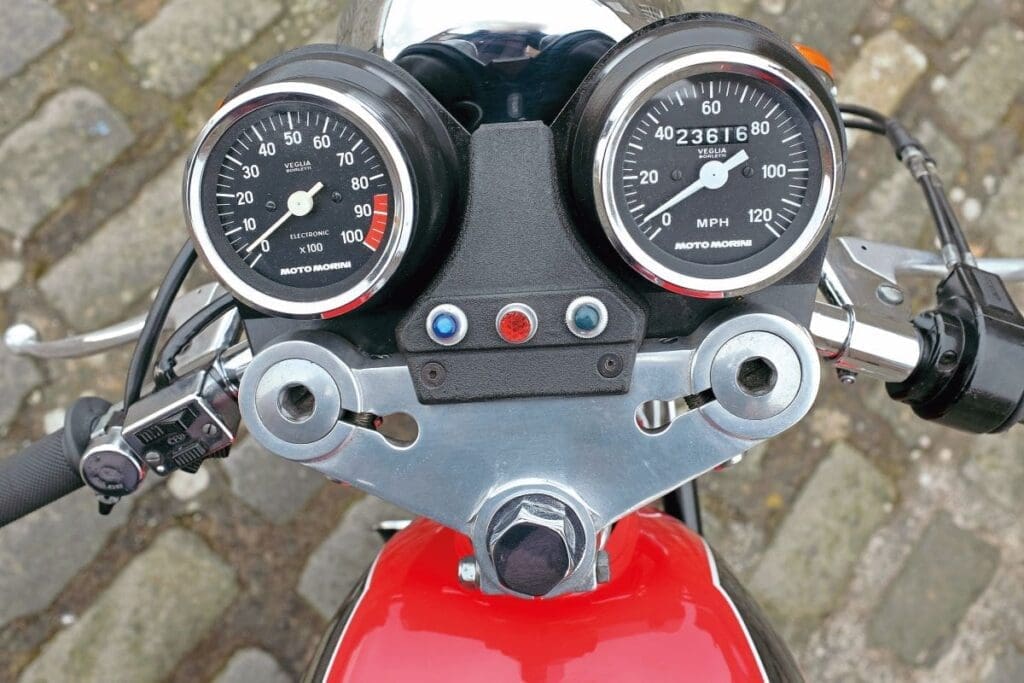
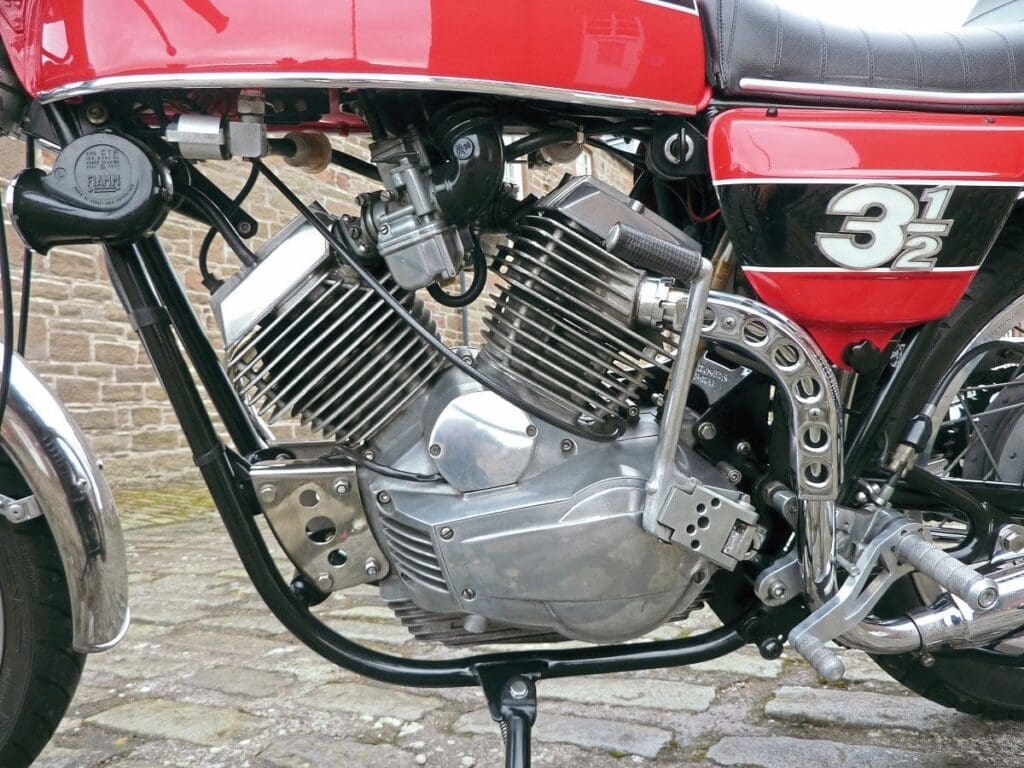
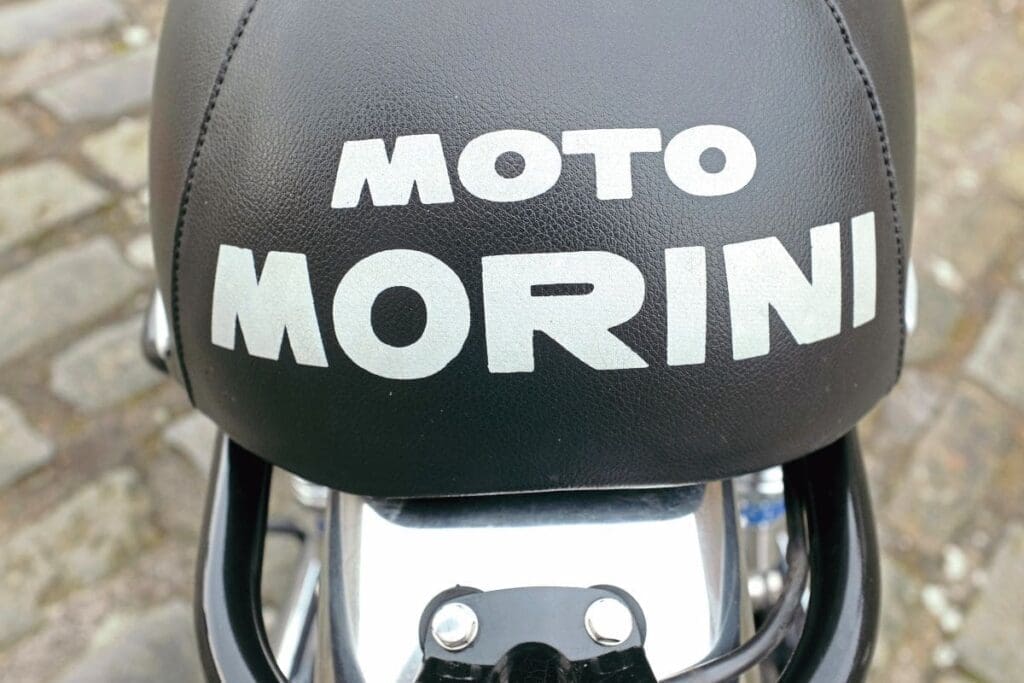
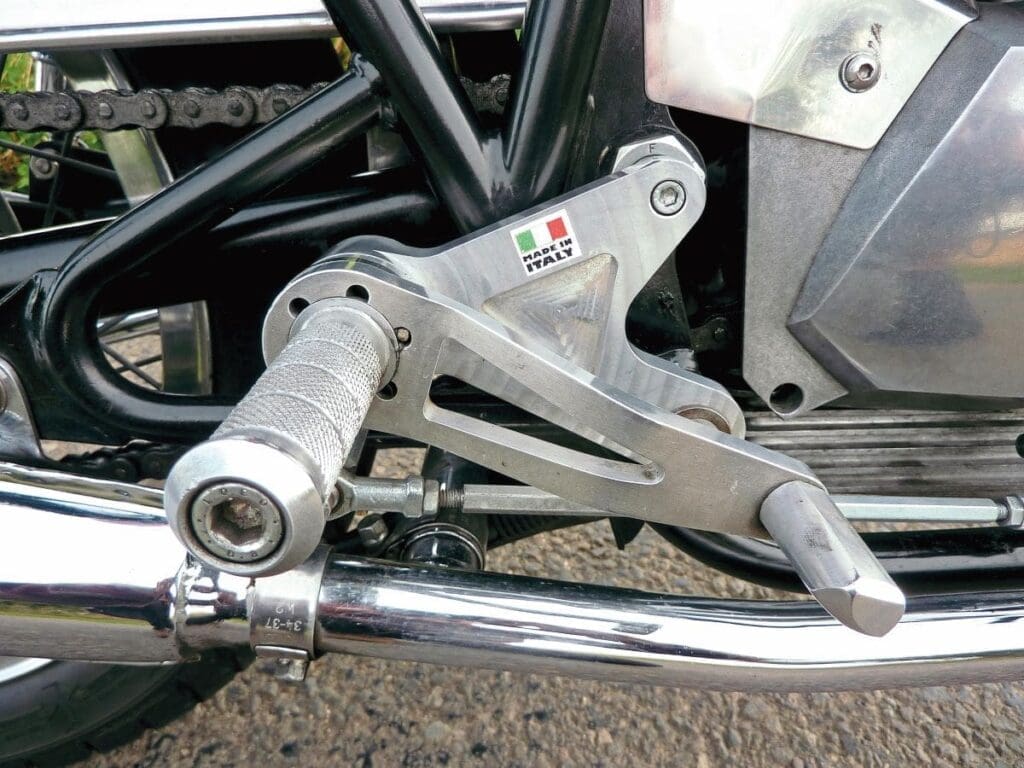
On the road again
“After checking the carbs were correctly set up, the V-twin started and ran extremely well. I love the responsive and eerily quiet performing engine, and the twin exhaust note is sublime. After I’d cured the snatching brakes, the ride was much improved, and the brilliant handling is in a class all of its own – only matched by my Norton Featherbed!
“Shakedown runs went extremely well, and the only let-down is the heavy shoe springs fitted to the Grimeca front brake. These tend to tire my hand on longer runs, but I aim to remedy this with lighter action springs in the near future.
“Given its unapproachable handling and an engine that feels in performance terms more like a 500 than a 350, I can’t help but think the Morini 3-1/2 Sport must have been an outright sensation when it was launched. Mine rips along at a comfortable 70-80mph without a hint of vibration or any worries that I’m revving the engine’s nuts off. At licence-burning speeds it still pulls well – which I find truly remarkable for a lightweight, four-stroke motorcycle.
“I’m also amazed at how many bikers tell me their mate has one, then I discover ‘…but it’s in bits’. To which I reply, “Tell them to get their Morini back on the road, chaps – without question, they’re missing out on one of the best and most sensational classic rides in sports motorcycling!”
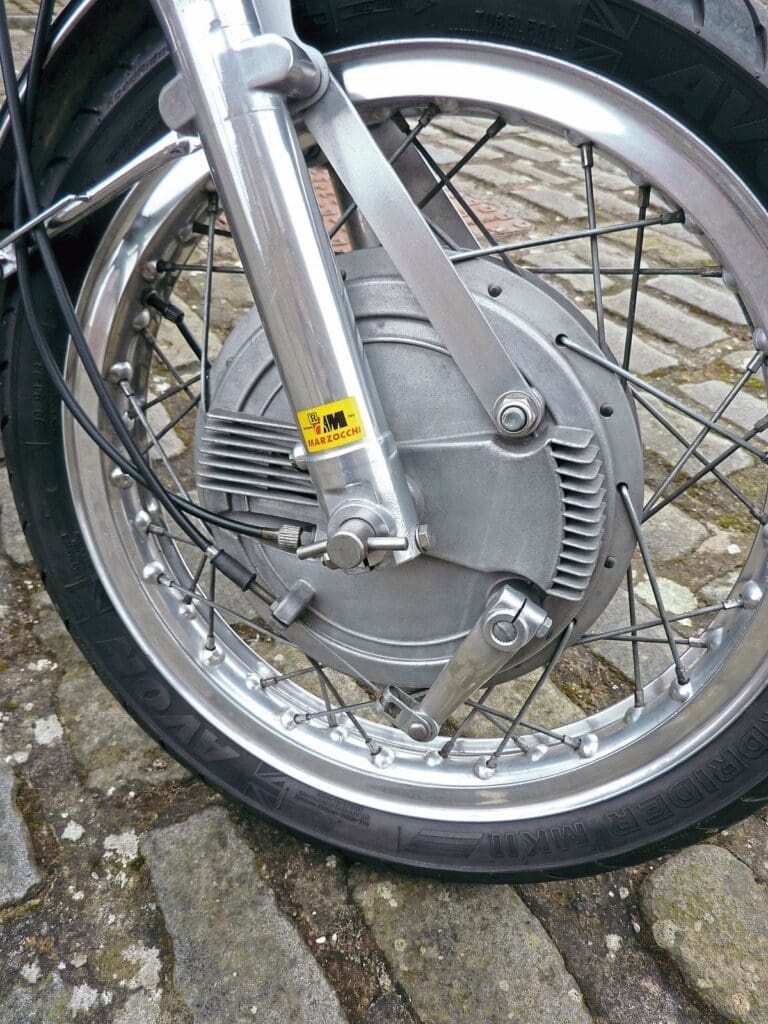
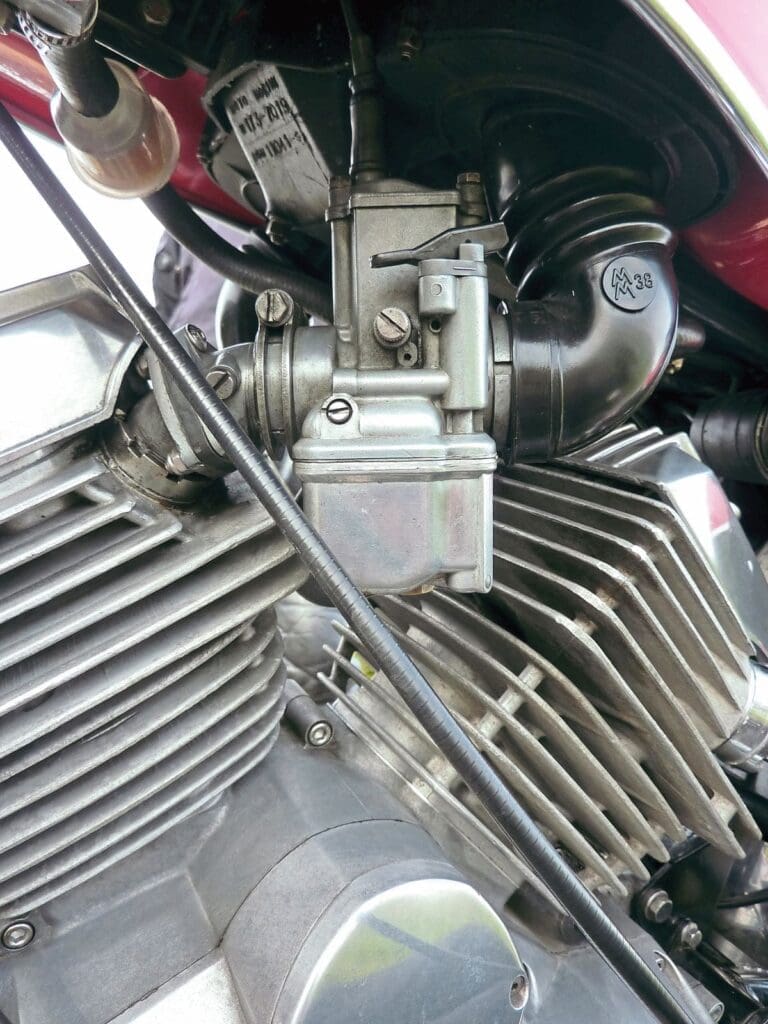
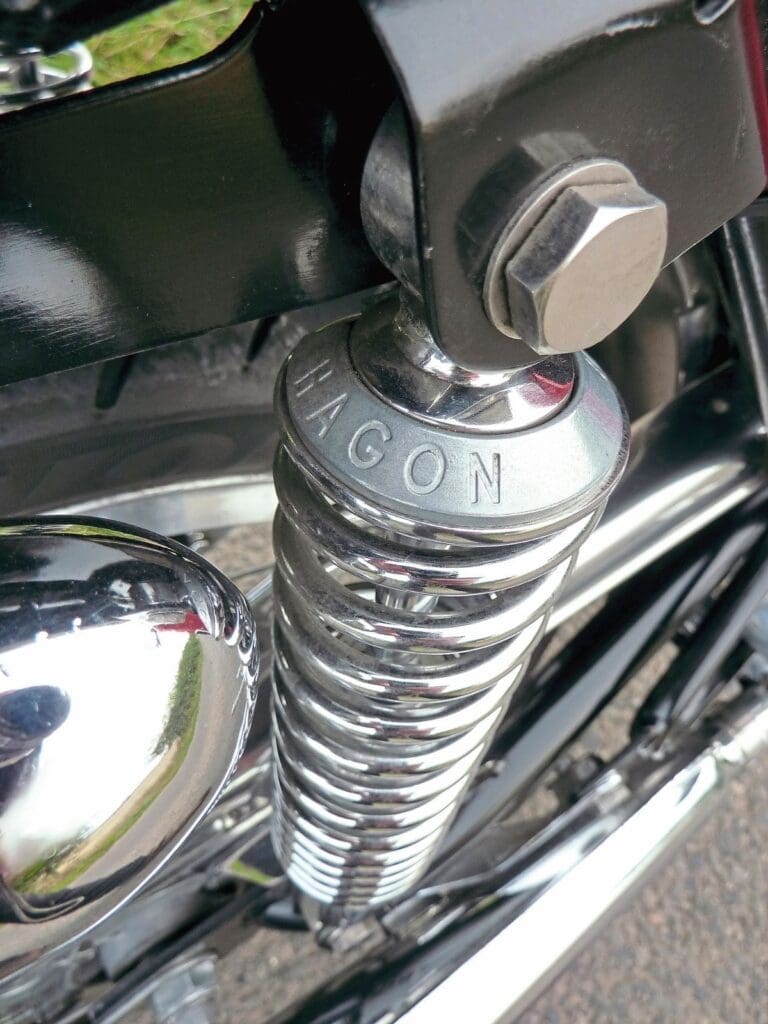
Riding impressions
Sitting uncomfortably on Mike’s stunning Morini Sport it felt alien, cramped, and a potential back-breaker. My initial surprise was how tiny it felt compared to my TR6 Trophy. “Left-hand kick-start – please start her for me, Mike?” I begged. He obliged, and with the engine throbbing, and the first of six gears selected silently, I instinctively felt this was going to be ‘one helluva ride.’ Then, paddling furiously, I dumped the clutch and whumped out from the car park and onto the narrow, twisty Glen Clova mountain road. I struggled to get comfy on Italy’s ‘mini marvel’ and almost fell over when my flailing feet failed to find the rearsets. I nervously glanced at the rear mirror expecting to see an impatient Mike frowning at my wobbly antics. Fortunately, my friend had yet to leave the confines of the car park, and I recovered, unnoticed, but then mounted the verge on the wrong side of the road. But once I’d engaged third and was buzzing along the black stuff at a stabilising 30mph, I began to connect with the pocket rocket’s controls…
Now sprawled ungainly across the fuel tank, the hand controls proved an easy reach – but my feet felt too far back, and building pressure on my legs and back brought shooting cramps up my right thigh. Oh dear. I reprimanded myself for making a right pigs ear of this test ride – whatever would Mike be thinking? I opened the throttle and in the blink of an eye saw 50 on the speedo, which thankfully permitted me to stretch my dangling limbs and ride out the cramps. The exhaust sounded gorgeous, and I relaxed by familiarising myself with the brakes, just in case the booming Vee startled several free-roaming sheep I’d noticed in the deep grassy verges.
Once past this woolly hazard I was in familiar territory – winding, twisting roads with good viz that the Sport would take in its stride. At last, I’d got my act together. But as the pace quickened I had to work out which gear I was in before I became distracted by the climaxing twin exhausts as we ripped along a section of straight mountain road. Then, minutes later I was flicking the delightful Morini through several tight bends that made sense of the ‘elbows tucked into knees crouch.’ Light, well-balanced and rapid, this little motorcycle flies and sings like no other I’ve ever had the good fortune and pleasure to ride. Some may not agree, but to me the Morini’s sporting aspirations are anything but pretentious – for a lightweight 350, the willing V-twin engine is amazing, the handling sublime. It’s just mega fun.
The faultless clutch and box deliver silky-smooth transmission, although I never thought counting through six gears could be quite so confusing! The charismatic 350cc engine can be docile when pondering scenery at lower speeds – however, I’d wager the ride ergonomics could prove tiring in the limitations imposed by city riding. But hey, you wouldn’t own such a devilishly sporting motorcycle unless you had access to country roads.
My novice ride lasted barely 30 minutes, but it was an exhilarating and uplifting blast through the heather-tinted mountain scenery. I was thrilled and entertained by the Sport’s performance and handling – ‘a smooth operator’ in every sense (sorry, Sade) it certainly pigeon-holed my own TR6 as agricultural, vibey and stuck in the past.
Gorgeous in form and delivering a performance well above its capacity, the Morini Sport 3-1/2 provides a sensational ride – I loved it! But this ageing enthusiast wonders if his auld limbs are supple enough to live with such a sports-focused motorcycle. Mike certainly does, and we are similar in stature and age – however, Mike keeps himself fit with his road cycling and competitive trials riding.
Me? I realise how I badly need a Sport, but which kind?
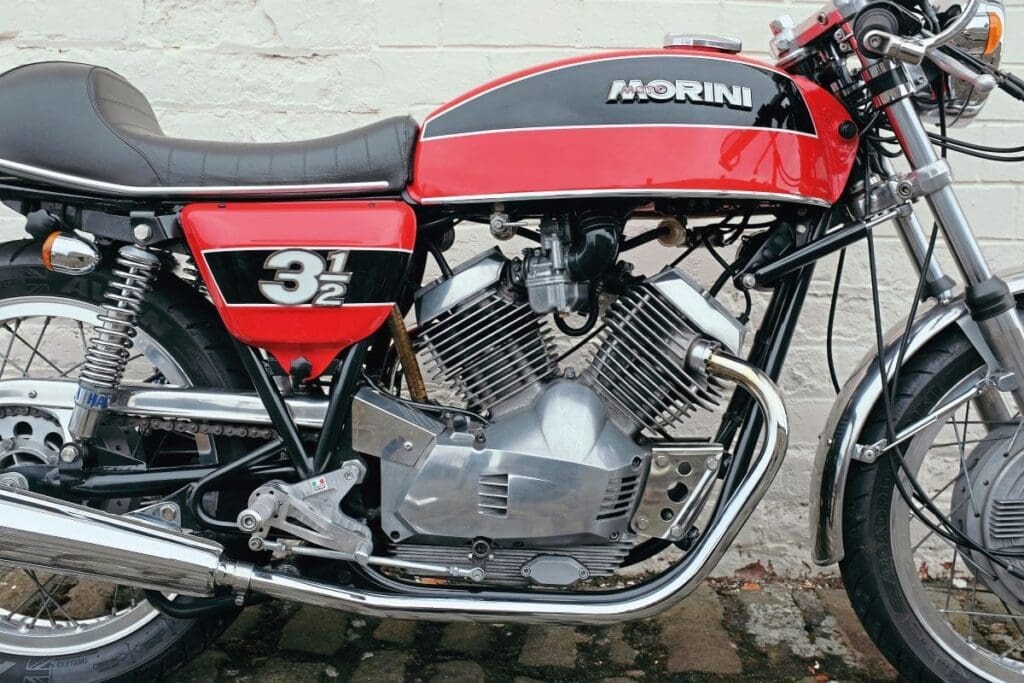
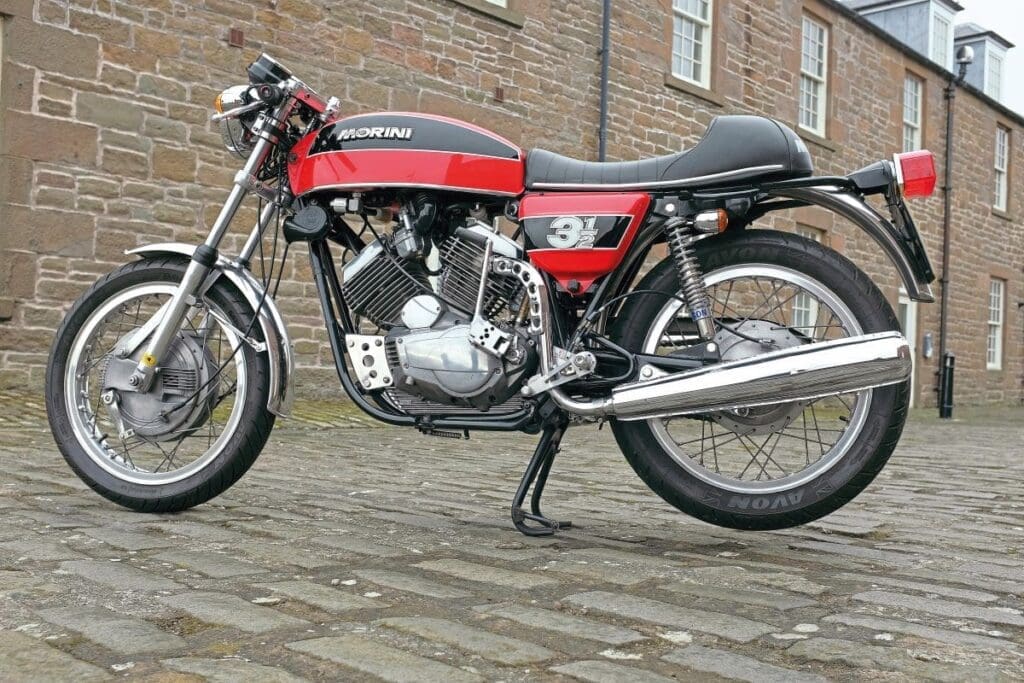
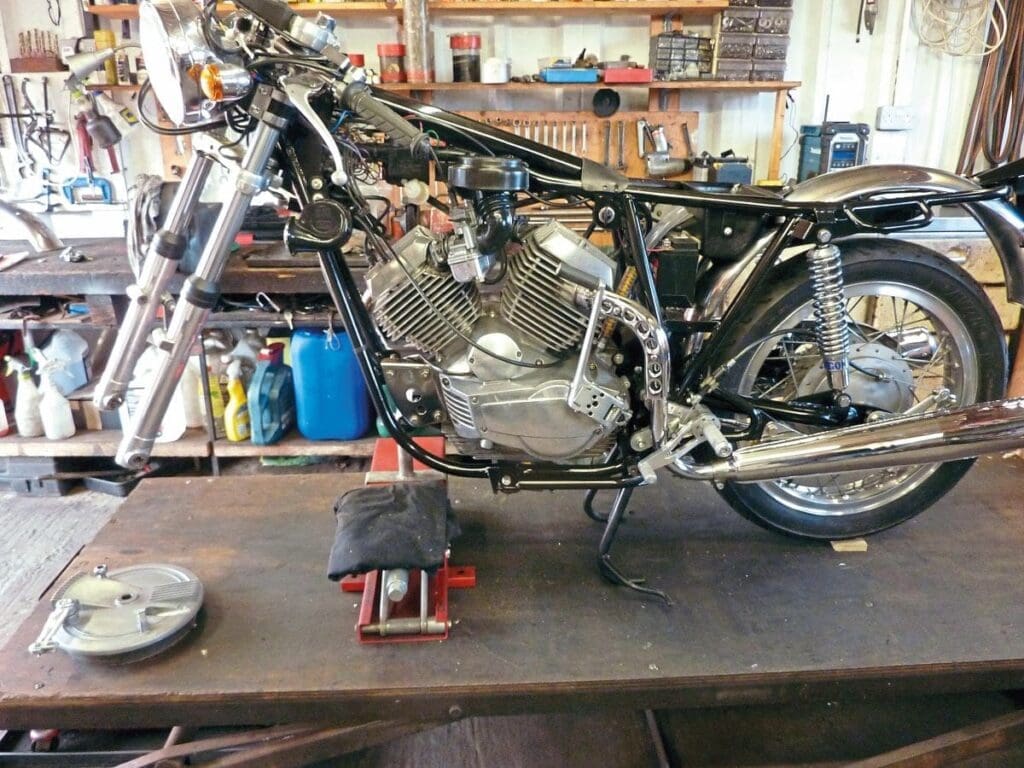
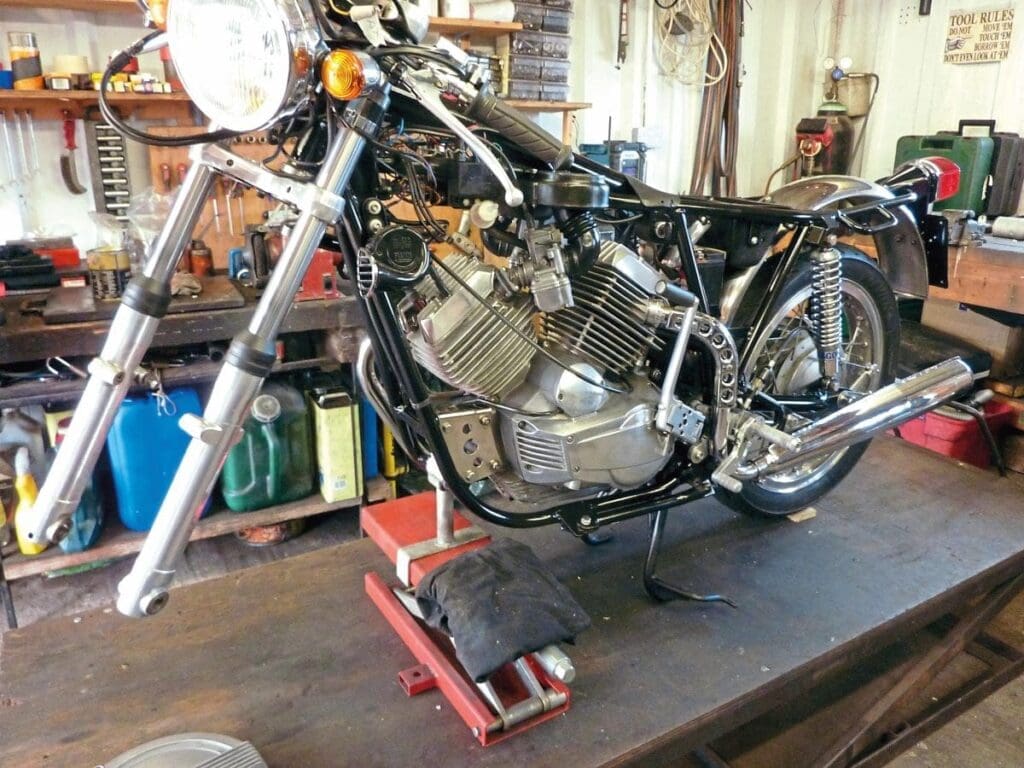
A short history
During the 1950s and 1960s, Moto Morini Motorcycles in Bologna, Italy, was known for producing 125cc and 175cc lightweight racing singles. Racing success with 175/250cc GP machines soon set Morini on the path to notoriety – especially when famous wins by rider Agostini would popularise the brand.
In 1969 after the death of founder Alfonso Morini, his daughter Gabriella Morini took control of her father’s company, becoming one of few women to manage a motorcycle factory. Just one year later, the enterprising Gabriella convinced Ferrari motor car designer Franco Lambertini to join Moto Morini and begin development work on new and forthcoming V-twin models.
Lambertini’s first design (launched at the 1971 Milan Show) was a four-stroke Touring 350cc GT V-twin bristling with automotive technology. Unusually, the engine (344cc) was a 72-degree twin, with ‘Heron’ flat combustion chamber heads and concave, machined pistons (pioneered in motor racing). Another Lambertini motorcycle ‘first’ was a toothed timing belt driven camshaft which operated parallel pushrods to lift vertical overhead valves. Fitted with identical heads, the rear pot faced backwards and was offset to aid air cooling. The new V-twin breathed through 28mm Dell’Orto (square) carburettors that featured separate choke levers located on top of each carb. Electronic ignition was fitted as standard. The engine’s bottom end had a wet sump and a one-piece crankshaft with bolt-together con-rods running on plain bearings. Transmission was via a six-speed gearbox and a dry clutch.
It was 1974 before the UK received the 3-1/2 Strada GT model. Although Morini dealerships were thin on the ground, the nippy and lightweight Strada soon attracted sales with its unique engine, excellent torque, rorty exhaust and smooth power delivery. A new Sport model appeared two years later and gained a loyal following all of its own thanks to exotic styling and desirable parts such as high compression pistons and a high-performance camshaft. Further additions of quality Marzocchi suspension, a 230mm Grimeca twin SLS front brake, alloy rims, single humped sports seat, clip-on handlebars, electronic ignition and alloy rearsets all added to the sporting model’s allure. A three-and-a-half-gallon tank proved useful for 200-mile-plus fuel stops and frugal fuel returns of about 65mpg. “The Moto Morini 3-1/2 Sport is not a bike you can effectively ride slowly, but who wants to do that?” – Bike Magazine, May 1975.
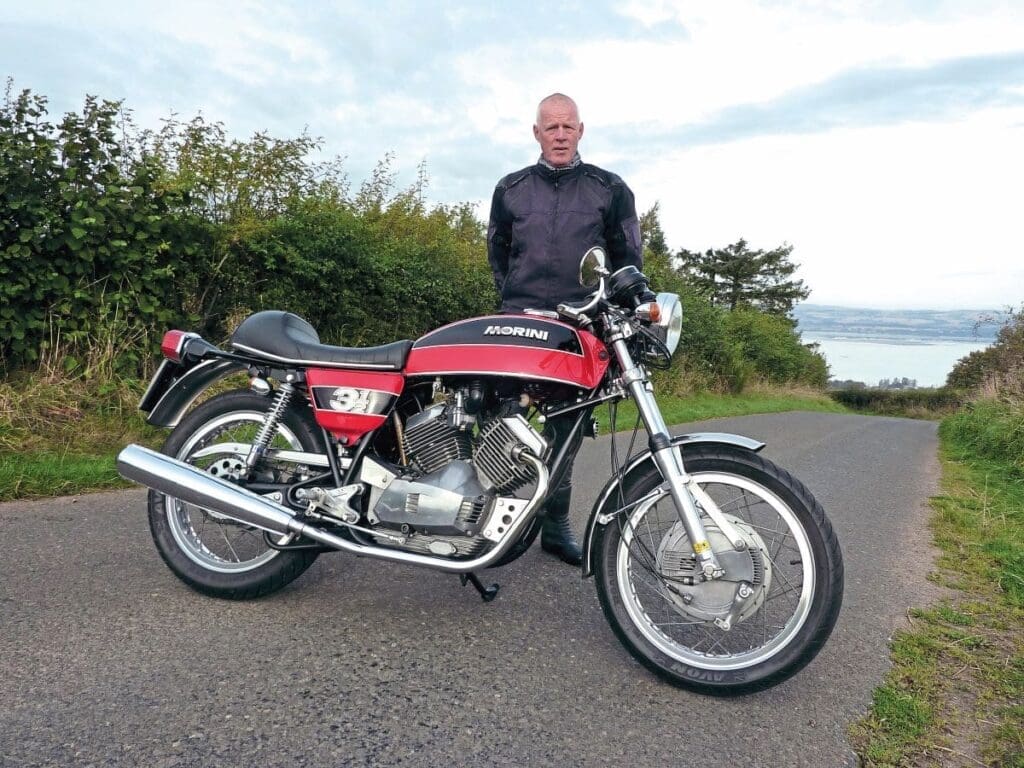
Unfortunately, some early Strada models were dogged by mechanical/electrical problems – not ideal for a motorcycle with showroom prices appreciably higher than the equivalent Japanese machines of the day. The Morini Sport cost £877 compared to £347 for the Yamaha RD350. Fortunately, performance problems were quickly resolved and the new Moto Morini Sport proved very successful.
Press reports praised the 350cc V-twin engine for punching well above its size. Further positives were the faultless six-speed box, light action clutch, overall performance and excellent handling. Apart from gaining cast wheels, disc brakes and small alterations like the fuel tank shape, the 3-1/2 changed little during its 15 years in production.
In 1978 Morini introduced the 500cc Maestro model to the UK with a longer stroke and larger barrels aimed at customers who desired more power. That same year also saw cast alloy wheels and disc brakes being introduced on Morini’s existing 350 models. Early Maestro models had a five-speed box, but this was later changed to six-speed. Then in 1983 the Japanese-styled K2 model was introduced with triple disc brakes, adjustable handlebars and alloy rearsets.
A lack of development and a fall in global demand saw Moto Morini being sold to the Cagiva group in the mid-1980s and unfortunately into relative obscurity. However, a lasting legacy of the Moto Morini V-twin is that the lightweight models of the 1970s and early 1980s are highly collectable and sought-after classics today.
